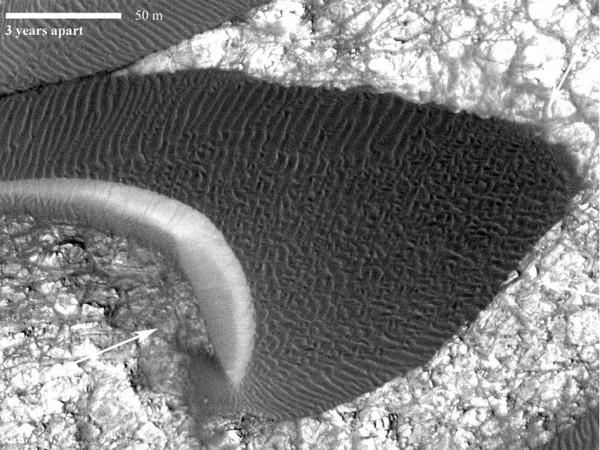
Nasa scientists have discovered that the movement of sand dunes on Mars appears in a large scale similar to the dune fields on Earth, according to a study.
Nasa's Mars Reconnaissance Orbiter (MRO) made the revelation which according to the scientists is unexpected because Mars's atmosphere is much thinner than the Earth.
The Red planet is just about one percent as dense as the earth, and its high-speed winds are less frequent and weaker than Earth's winds.
"This exciting discovery will inform scientists trying to better understand the changing surface conditions of Mars on a more global scale," said Doug McCuistion, director of NASA's Mars Exploration Program in Washington.
"This improved understanding of surface dynamics will provide vital information in planning future robotic and human Mars exploration missions," he added.
For years, researchers believed that the sand dunes on Mars were mostly fossil features related to past climate and were not active. The scientists studied the High Resolution Imaging Science Experiment (HiRISE) taken by MRO of the Nili Patera sand dune field located near the Martian equator in 2007 and 2010.
They used a software tool to determine the changes in the position of sand ripples. The images revealed that the ripples were moving much faster on the dune.
By analysing the ripples they noted that the entire sand dunes as thick as 200 feet were moving as coherent units across the Martian landscape, according to Nasa.
"We chose Nili Patera because we knew there was sand motion going on there, and we could quantify it," said Nathan Bridges, a planetary scientist at Johns Hopkins University Applied Physics Laboratory in Laurel, Md., and lead author of the Nature paper.
"The Nili dunes also are similar to dunes in places like Antarctica and to other locations on Mars," he added.
Scientists believe that the new study will help them understand more about the pace at which the blowing sands could erode the rocks on the Mars. With the information, they will seek to understand the mysteries on Mars.
"Our new data shows wind activity is indeed a major agent of evolution of the landscape on Mars," said Jean-Philippe Avouac, Caltech team leader.
"This is important because it tells us something about the current state of Mars and how the planet is working today, geologically."
The study has been published in the online Nature journal.










